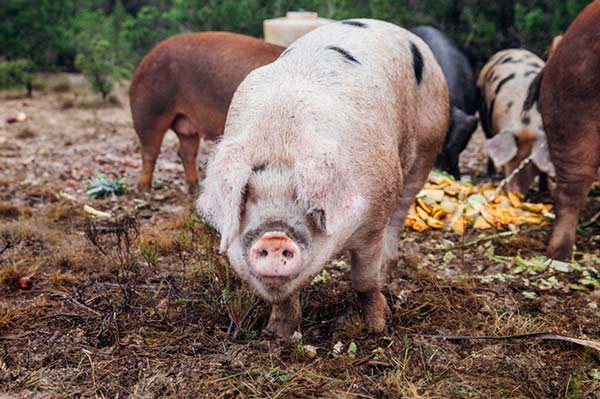FEATURED FARMERS:
Tina & Orion
Weldon
“This work changes
the relationship of
humans to the land.”



They are kind of like Chip and Joanna Gaines of Magnolia, except instead of flipping houses, they flip soil. They met in graduate school at Rutgers University and if you can believe it – regenerative agriculture was the reason they fell in love. Orion recounts it like it was yesterday…
Not only did they start out without financial support, they were $38,000 in debt. Then an unexpected move back home to care for Orion’s Dad derailed their plans to move abroad to Turin, Italy where the slow food movement began. This left Tina holding down two jobs as a waitress and cashier at Whole Foods and Orion was collecting unemployment while caring for his Dad. So they found the silver lining in the haystack of obstacles and started to use the 5 acre as testing ground in Spicewood Texas.
“We decided to ‘test’ our hands at regenerative practices while living there and opportunities started cropping up: first a partnership with Apis Restaurant & Apiary, then Whole Foods for food waste collection to feed our animals, and then Barton Springs Mill to make them a zero waste facility. It soon became clear that the Hill Country is where we needed to be, in terms of the most land regeneration potential and business opportunity.”

Like a clock that never stopped ticking, it’s this dedication and persistence that caught the eye of Annie Nelson, Willie Nelson’s wife, and ultimately became the opportunity of a lifetime – to regenerate 500 acres on Luck Ranch in the heart of Spicewood, Texas. Annie frequented the Pedernales Farmer’s Market (co-founded by Orion and Tina), watching and learning how they operate. After four years of seeing how driven they were to create a regenerative system within the community, and more importantly, how they were doing the work, day in and day out, year after year, she was convinced and invited Tina and Orion to the ranch where they sat down at a picnic table and invited them to apply their mastery to their ranch.
As we walked through the first segment of the ranch slated to be regenerated, you could see the cyanobacterial layer that happens when you get surface sealing of the soil. When you get surface sealing, you don’t get effective water infiltration so the rainfall dancing around us hit the ground and you could see the instant run off. The signs of degraded land were all around us, but so was the hope for a regenerative solution.
“Every aspect of agriculture can be done better.”
Here’s what that looks like in a typical day:
Every single day Orion is up and at ‘em spending nearly five hours on the roads of Austin in an electric vehicle picking up food waste from four local Whole Foods locations that cannot be donated and would otherwise be left disposed of to off-gas methane.
That “food waste” is hauled to the two ranch properties the Weldon’s are regenerating, including Luck Ranch, which gets fed to the heritage breed pigs whose work is to break the soil’s hard surface improving the soil’s permeability encouraging the regrowth of natural vegetation and making way for sowing native grassland seeds. The unknown seed banks that exist deep below the land’s surface, just waiting to be restored over the course of this regenerative project is thrilling.


The Weldon’s have a completely mobile operation which they can apply to multiple properties, pigs included, with little upfront cost and infrastructure. They can take their entire production on the road and apply these techniques on multiple plots of land. They want to show other people who want to get into farming that it’s possible to do even if you don’t have funding or land to start.
“We want to be able to speak to people who don’t have outside investors and not only be able to say yes, this is possible, but have a learning institute where they can learn how.”
Tina shared what she believes to be the grounding undercurrent of their success, “Sticking to our principles with every decision, and never cutting corners has been the key. We put in the hard work and time in order to ensure that we are doing everything the best possible way. We need to show that this is a financially sound approach to agriculture, however we are unwilling to compromise our practices to get there sooner or to make more money. Through this perseverance, it has paid off: people see that we are authentic and are doing what we say we are doing. This has presented numerous new partnership opportunities and access.”
The Weldon’s, and many farmers would agree, it takes a village to raise a farm. Pairing their work on the ground with the microphone of Willie Nelson and his family has astounding potential to place regenerative agriculture onto the global stage making this partnership the greatest hit of all time. The Nelson’s have supported farmers for decades including when Willie joined forces with Neil Young and John Mellencamp to organize the first FarmAid concert in 1985 to raise awareness about the loss of family farms and to raise funds to keep farm families on the land and has since supported The Farmer Suicide Hotline with revernece for the mental health of farmers.


First, they observe.
They look at the original conditions while taking into account the history of that area asking questions about what species of grass are present and find out if they are native, introduced, or invasive.
Second, they experiment.
After the first pass of pigs they seed cover crops and native grasses, and let them rest for two growing seasons. After observing how the grasses grow, they reassess. They may put the pigs through one more time or set a schedule to bring through chickens and then ruminants for maintenance.
Experience is their greatest teacher as they learn and optimize their process based on what the ecosystem is responding to and what the data confirms to be true.

Come rain or come triple digit shine, Tina and Orion have a goal and won’t stop until they’ve made a difference. Like the aged native seed beds laying dormant below the surface of the ground at Luck Ranch, just waiting to be set free, the unyielding vision of Tina and Orion is just beginning and sure to produce an abundance of knowledge, opportunity and viability within the regenerative movement.
Connect and learn more about their work here:
CONTACT:
Donate to support their work and native seed fund: www.patreon.com/terrapurezza
Farmer’s Markets:
Pedernales Farmer’s Market
Sundays 10-2pm at Apis Restaurant & Apiary, 23526 TX-71, Spicewood, Texas
Dripping Springs Farmer’s Market
Veterans Memorial Park – Hwy 290 & RR 12
Dripping Springs, Texas – Wednesdays 3-6pm



